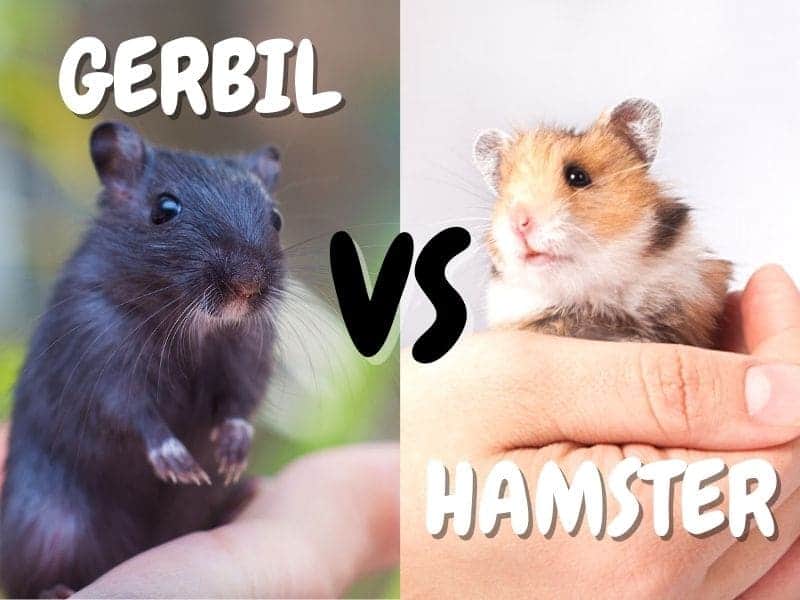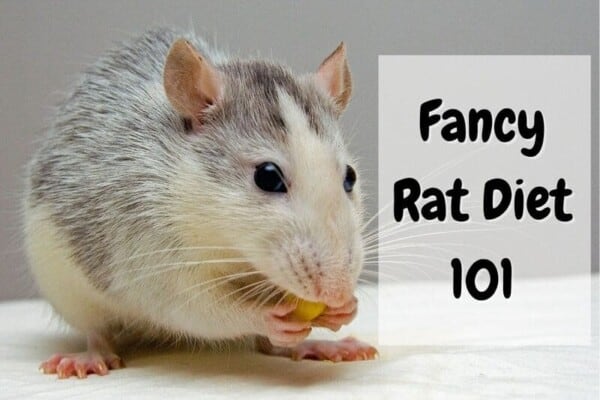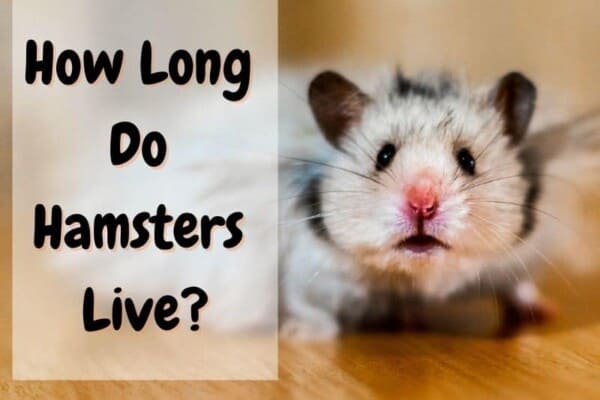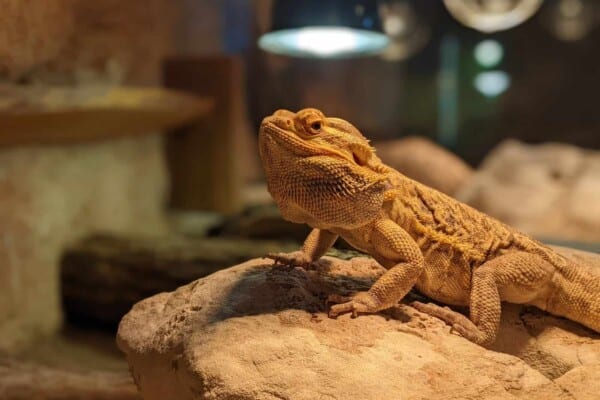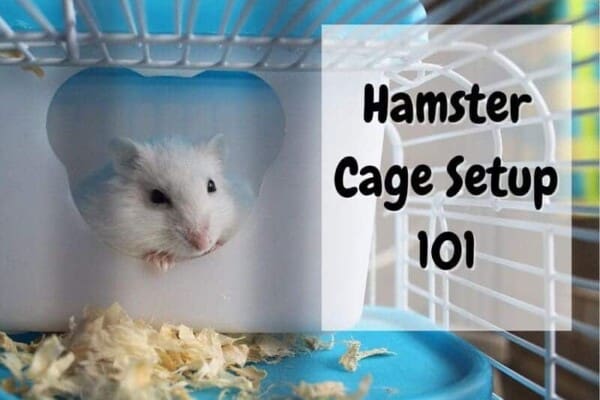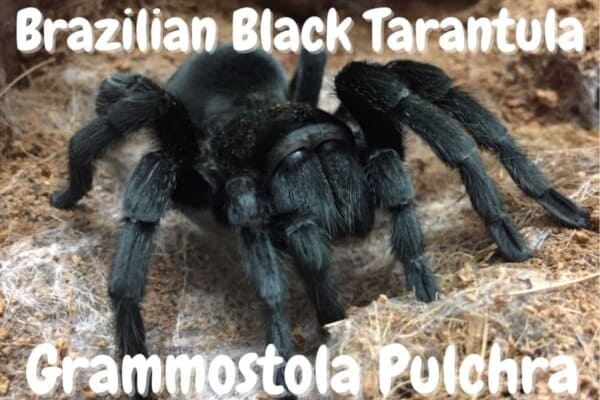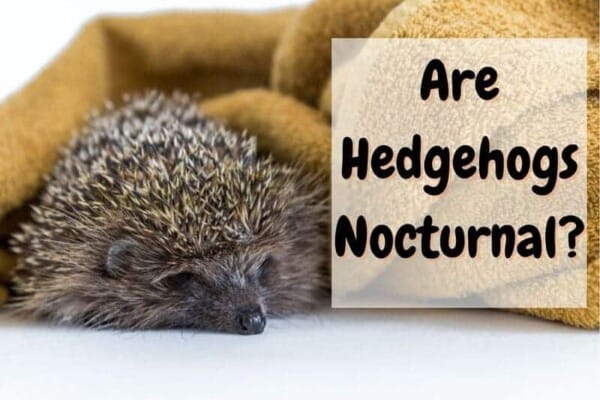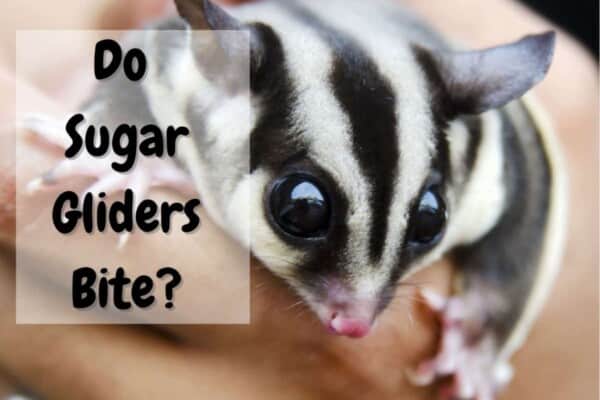Are you wondering what is the best pet to keep between a hamster and a gerbil? In this article, we are going to explore 9 differences between gerbils and hamsters so that you can decide which one is the best option for you to keep as a pet. We are going to go over everything that sets them apart as well as understand what it means to keep each one as a pet.
9 Main Differences Between Gerbils and Hamsters
| Gerbils | Hamsters | |
|---|---|---|
| Size | 4 inches (+ tail) | 6-8 inches (Syrian) / 2-4 inches (Dwarf) |
| Personality | Social | Solitary |
| Lifespan | 2-4 years | 2-4 years |
| Price | $10-20 USD | $10-20 USD |
| Trainability | Easy | Medium |
| Habitat | Tank | Large Cage |
| Diet | Omnivores | Omnivores |
| Health Issue | Less Frequent | More Frequent |
| Geographical Origins | Asia | Europe and Asia |
1. Physical Differences: Gerbils Are Leaner Than Hamsters
Gerbils
Gerbils have long tails – 4 inches long on average, which is about the same length as their body. Some species of gerbils have tails covered in fur (such as the Mongolian gerbil), while other species have bald tails (such as fat-tailed gerbils.)
Gerbils have narrow faces with long noses that are somewhat similar to a rat face. Their bodies are also long and lean, with long powerful legs and large feet. This body type makes gerbils fairly acrobatic.
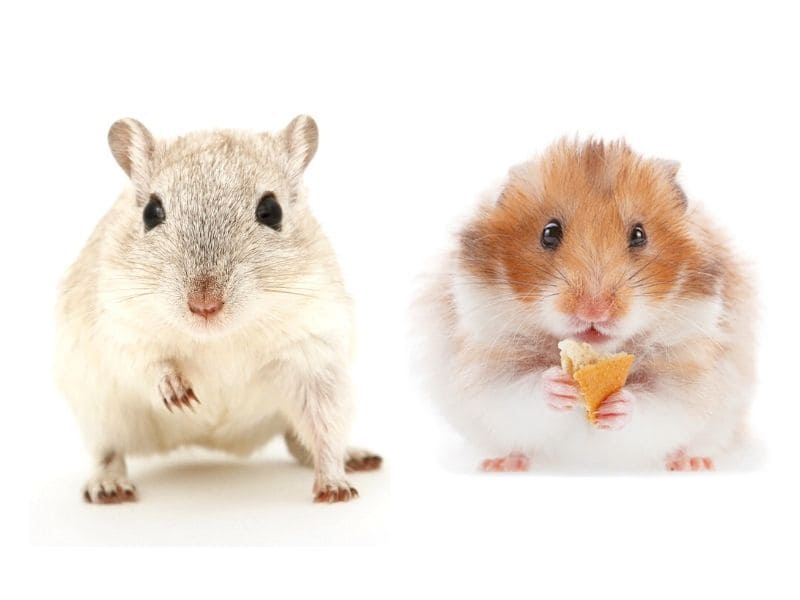
Hamsters
Syrian hamsters are about 6-8 inches tall, while dwarf hamsters are much smaller, between 2 and 4 inches. Their bodies are pretty short and round, which makes them appear almost like a little balls of fluff.
Hamsters tend to have very short, stubby tails, with the exception of the Chinese hamster which does have a long tail. Their faces are usually round with short, blunt noses. The most distinctive physical feature of a hamster’s face is the cheek pouches that they use to carry food.
2. Personality and Temperament: Gerbils Are More Social Than Hamsters
Gerbils
Gerbils are extremely inquisitive and curious little creatures. You may notice that whenever a gerbil is awake, he is running around and exploring the cage. They also really enjoy any time that you can give them outside of the cage to explore a bigger, controlled space.
Gerbils are also very social creatures, both with other gerbils and with humans. Gerbils often really enjoy having cage mates, and they will thrive when they are getting plenty of attention from humans. Though they might be shy at first, they bond quickly with owners whom they spend time with and they rarely ever bite.
Hamsters
Hamsters are also very active and curious creatures. They thrive when they have plenty of ways to get that energy out, such as running on a wheel or playing with climbing toys. If you keep your hamster by your bed, it will make noise at night since hamsters are nocturnal.
Unlike gerbils, hamsters are not very social creatures. There are a few breeds that may get along with other hamsters, but for the most part, they can be fairly territorial. However, they still do fairly well with human interaction, especially if you start handling them at a young age.
You can also pick your hamster breed based on how much interaction you want with your hamster. Some breeds like Syrian hamsters tend to be more friendly while others such as Roborovski hamsters can be more high-strung.
Takeaway Point: Pet Gerbils Need to Be Kept in Pairs, Hamsters Don’t
Gerbils need to be kept in pairs or small groups in order to fulfill your gerbil’s need for social interaction. In fact, many breeders and pet stores will not sell you a gerbil unless you buy at least two.
On the other hand, many hamsters prefer to live on their own. Breeds like Syrian hamsters can be aggressive and territorial and therefore should never be kept in a cage with other hamsters. Some dwarf hamster breeds, however, do okay in pairs or small groups, but they should be carefully watched because they can still become territorial and start fights.
3. Lifespan: Ex-Aequo
In captivity, gerbils tend to live somewhere between two and four years.
Your hamster’s lifespan will depend on the breed:
- Syrian hamsters tend to live for about 3 years.
- Chinese dwarf hamsters tend to live for slightly less than 2 years.
- Campbell and Russian dwarf hamsters both live for an average of 2 years.
- Roborovski hamsters tend to live about 3-4 years
However, for both gerbils and hamsters, the length of their lifespan can vary a lot based on a variety of different factors. Some of these factors are genetic, while others are care-related.
Read also: 13 Tips to make your hamster live longer
4. Price: Both Critters Cost the Same
Gerbils and hamsters are actually fairly similar when it comes to how much they cost. Most gerbils and hamsters at pet stores will cost somewhere between 10 and 20 dollars per animal, though you may find breeders that sell some special animals for significantly more (up to 100 dollars.)
However, even if gerbils and hamsters cost the same at the pet store, you will likely end up spending more if you get a gerbil because you have to buy multiple.
The cost of owning a hamster will be a little less than the cost of owning gerbils, simply due to the fact that keeping several gerbils means buying more food, toys, and other accessories.
5. Trainability: Gerbils Are Easier To Train
Gerbils
When you first bring home a gerbil, you are going to need to focus on is hand training. Hand training is the process that you will go through to get your gerbil used to human interaction and being held so that they do not bite you or feel scared when you pick them up. Once you are done hand training your gerbils, you can train them to use a litterbox, respond to their name, or even perform a few different tricks.
Hamsters
As soon as you bring home a hamster, you also want to start with hand training, though you usually need to move a little slower than with gerbils. Start by hanging out by the cage and talking to your hamster, and slowly work towards actually handling him. Just like gerbils, hamsters can learn a few tricks once you have formed a bond with them.
Takeaway Points: Gerbils Need More Human Interaction
Gerbils thrive when they are getting plenty of interaction with other gerbils and with humans. They can form close bonds with humans that they interact with regularly and may become depressed or stressed if left alone in the cage for too long.
Some hamsters, like Syrian hamsters, can really grow to enjoy human interaction, while other breeds like Roborovski hamsters often are perfectly happy on their own.
If you are looking to get a pet that your kids can help care for, gerbils are the better option. They tend to be a bit more docile and do better being handled by humans. However, that does not mean hamsters cannot be good pets for children to help with, but you should carefully consider the breed. For example, Syrian hamsters are often better with kids than dwarf breeds.
6. Habitat: Hamsters Need a Larger Cage
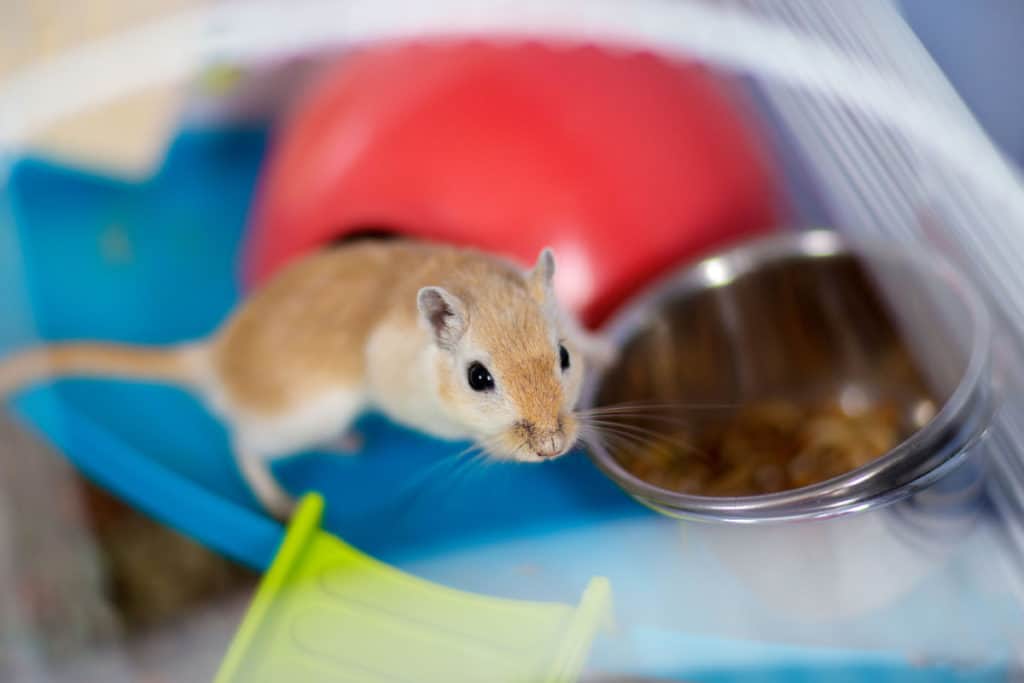
Gerbils
A good gerbil cage setup is very important. They love to explore, run, and chew, which means that you have to carefully consider what kind of cage you get to make sure that your gerbil does not escape and get himself injured. For gerbils, a glass aquarium is the best choice. A metal habitat that they cannot chew out can also be used, but you need to make sure the bottom of the cage can retain bedding and is smooth so that it does not hurt your gerbil’s feet.
Beyond safety, you need to make sure you can meet your gerbil’s other needs with his habitat. You want to make sure that there is plenty of bedding that your gerbil can use to dig, burrow, and nest in. You also want to make sure there are things that your gerbil can chew on and that it is big enough for the number of gerbils that you keep together.
Hamsters
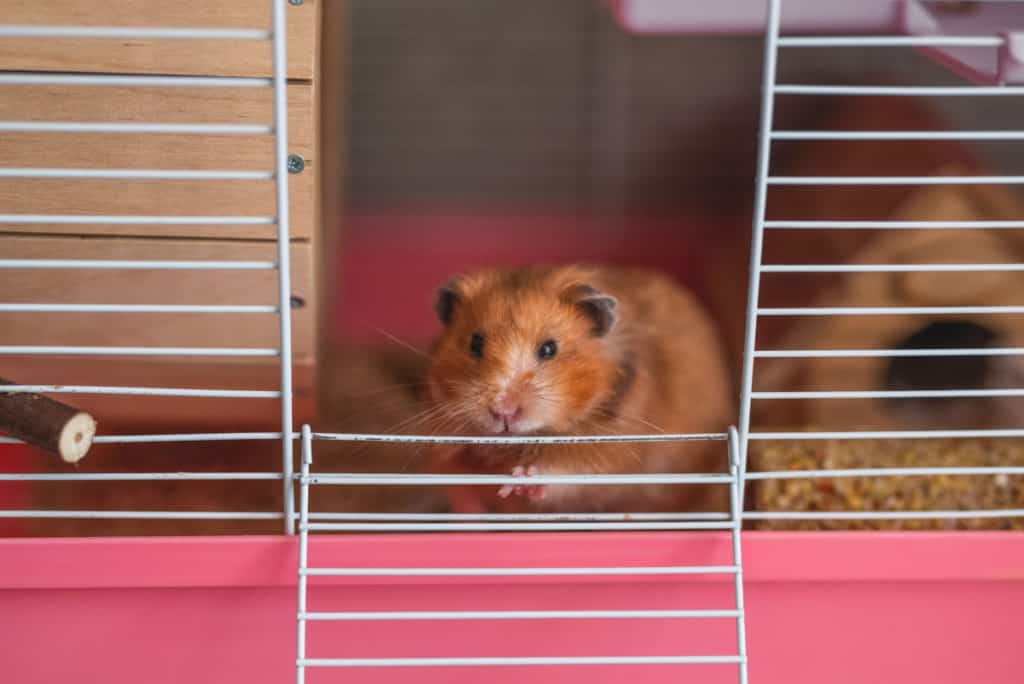
Hamsters, like gerbils, love to explore, chew, and dig; and while they are not big jumpers, they do love to climb. Like gerbils, you want a hamster cage setup that will keep your hamster secure and safe. You can get a glass or metal cage, but there are also some plastic cages that will work for certain hamster breeds. If you do decide to get a cage with bars, you need to make sure the bars are close enough together that the hamster cannot escape and that the bottom is smooth to protect your hamster’s feet.
You also want to make sure you give your hamster a few different ways to get his energy out. You will definitely need a hamster wheel for exercise and a few different climbing and chewing toys. As far as size goes, when it comes to hamsters, the bigger the cage, the better.
Takeaway Point: Pet Hamsters Need a Bigger Cage Than Gerbils.
Hamsters need a bigger cage than gerbils to be happy. You want the cage to be at least 450 square inches of space per dwarf hamster. That means if you are going to keep two dwarf hamsters together, you will need at least 900 square inches.
Syrian hamsters are solitary so you can only keep one hamster per cage. Syrians need at least 620 square inches of space. This space needs to be continuous, meaning not divided up into rooms and connected by tunnels.
But since gerbils are more social and not as territorial as hamsters, you can keep two gerbils in a cage or tank of 400 square inches. Similar to hamsters, the more space you can offer your gerbils, the better.
7. Diet: They Are Both Omnivores
Gerbils
When it comes to gerbils, you can decide to feed your gerbil a commercial food or make your own mixture. Commercial foods usually come in pellets or food mixes. You can also choose to make your own food for your gerbil, but you should probably do so with the help of a vet or expert to make sure you are getting your gerbil the right nutrients.
Gerbils need a balanced diet with about 14 to 15 percent protein and 6 to 9 percent protein with very little fiber. Too much protein can lead to liver damage, kidney stones, and skin lesions, while not enough protein can stunt growth. On the other hand, too much fat can lead to problems such as obesity and high cholesterol.
Hamsters
A hamster’s diet is similar as they tend to eat lots of seeds and grains, but they are actually omnivores, not herbivores, so they need a decent amount of protein in their diet. Hamsters should get about 18 to 23 percent protein. Just like gerbils, not getting the correct nutrients can cause health problems in hamsters.
Hamsters can be fed through a commercial pellet mix, or you can make up their food yourself. The biggest problem that you might come across with hamsters is that they tend to pick through mixes and only pick out their favorite ingredients. Because of this, sometimes uniform pellets are the best way for you to guarantee that your hamster gets all the nutrients he needs.
Takeaway Points: Pet Gerbils and Hamsters Have Pretty Similar Diets
When it comes to food, there is not a whole lot of difference between gerbils and hamsters so the money you spend on food would be the same, depending on the number of critters you are keeping.
In terms of quantity, if you are feeding your animal with pellets, you are going to need to give your gerbil a heaping teaspoon of food every day. Dwarf hamsters need about one teaspoon of food, and Syrian hamsters need about two hamsters per day.
You can give both hamsters and gerbils a few special treats in addition to their regular food.
8. Health Issues: Hamsters Are More Fragile Than Gerbils
Gerbils
There are several different diseases and health problems that gerbils commonly get, such as fleas, mites, colds, and diarrhea. The good news is most of these things are very treatable, especially if caught early. If you start to notice signs that your gerbil is not feeling good, you should immediately take him to the vet. You also want to make sure you avoid any accidents. Dropping or stepping on your gerbil can be extremely harmful, and things like heatstroke can also be harmful and even fatal for gerbils.
Hamsters
Hamsters are also highly susceptible to a variety of different illnesses such as skin diseases, digestive problems, teeth problems, and respiratory infections. Hamsters can even catch colds like humans. Most of these conditions are treatable, but you want to get your hamster to the vet as soon as you can. Just like with gerbils, you want to be careful to avoid any accidents. Any time you are holding your hamster, make sure he is secure and always be aware of where your hamster is when he is out of his cage.
9. Geographical Differences
Gerbils
In the wild, gerbils can live in a variety of different climates. They can live in deserts, grasslands, and mountain valleys. For this reason, you can find them in several different countries such as Mongolia, Southern Siberia, and Northern China. No matter where they live geographically, you will usually find wild gerbils living in small groups that make their homes in burrows in the ground.
Hamsters
There are almost twenty different species of hamsters in the world, so you can find them in many different locations around the world. The 5 main hamster breeds you can keep as pets can be found mainly in Russia, Mongolia, China, and Syria, but you can find wild species of hamsters in Greece, Romania, France, and Belgium. However, you will not find any wild hamsters in North America.
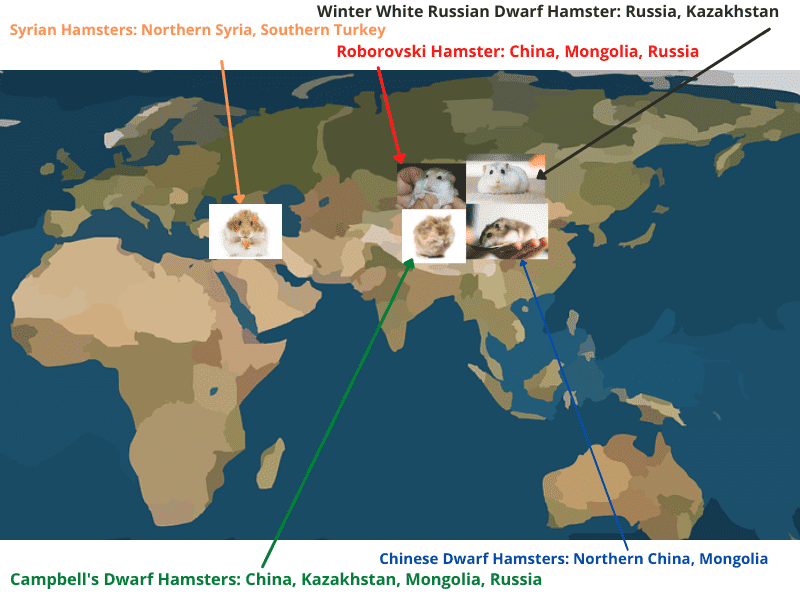
Similarly to gerbils, hamsters in the wild tend to live in burrows under the ground; however, whether or not they live in groups or by themselves depends on the species of hamster. Unfortunately, many of these wild hamster species are considered endangered.
Related: Where do hamsters live in the wild?
Gerbil VS Hamster – Frequently Asked Questions
Are Hamsters and Gerbils Noisy at Night?
While gerbils can be active at night, they are not nocturnal and are usually most active during the day. On the other hand, hamsters are nocturnal and are most active at night, which means they tend to make a good bit of noise through the night.
So if you are concerned about noise at night, the gerbil is likely your best bet, even though you must expect a fair amount of noise at night when they are awake playing or foraging for food.
Is a Hamster or a Gerbil Best For a Child?
Both hamsters and gerbils can be pets for a child, but gerbils are often a little easier as they tend to be more docile. No matter which animal you get, you are going to need to educate your child on how to properly handle and care for the animal, and you are also going to need to consistently supervise any young children interacting with the animal.
Do Gerbils And Hamsters Bite?
As long as you train your hamster or gerbil from a young age to be handled and held by humans, you should not have a lot of trouble with biting. Gerbils rarely ever bite, and hamsters will usually only do so if they feel threatened or startled.
Can You Put A Gerbil And A Hamster In The Same Cage?
No, you should never put a gerbil and a hamster in the same cage. While gerbils are docile and generally friendly, hamsters can be territorial and sometimes aggressive. If you decide to put a hamster and a gerbil in the same cage, the hamster will start a fight, and either animal could end up getting seriously injured or even killed.
Related articles
Contents
- 9 Main Differences Between Gerbils and Hamsters
- 1. Physical Differences: Gerbils Are Leaner Than Hamsters
- 2. Personality and Temperament: Gerbils Are More Social Than Hamsters
- 3. Lifespan: Ex-Aequo
- 4. Price: Both Critters Cost the Same
- 5. Trainability: Gerbils Are Easier To Train
- 6. Habitat: Hamsters Need a Larger Cage
- 7. Diet: They Are Both Omnivores
- 8. Health Issues: Hamsters Are More Fragile Than Gerbils
- 9. Geographical Differences
- Gerbil VS Hamster – Frequently Asked Questions

